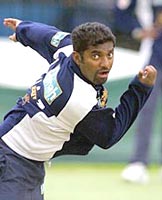When a player of Muttiah Muralitharan's eminence stands at the centre of the controversy swirling around the issue of chucking, the matter inevitably loses objectivity ... and even the prime minister of a premier cricketing nation, who ought to know better, joins the fray by expressing his opinion in strong words about the Sri Lankan's bowling action.
When Murali was first called some nine years ago, the matter was resolved with high-tech equipment revealing that it was the rotation of his congenitally bent arm that gives an optical illusion of arm-straightening - and thus of "chucking".
 Later, with the likes of Bret Lee, Shoaib Akhtar, Harbhajan Singh, Saqlain Mustaq, Jermaine Lawson, Sanwar Hossain and Shabbir Ahmed joining the list of "suspects", and more studies having been conducted, it has come to light that the arm (at the elbow-joint) of almost all the bowlers undergoes a slight straightening at the instant of delivery.
Later, with the likes of Bret Lee, Shoaib Akhtar, Harbhajan Singh, Saqlain Mustaq, Jermaine Lawson, Sanwar Hossain and Shabbir Ahmed joining the list of "suspects", and more studies having been conducted, it has come to light that the arm (at the elbow-joint) of almost all the bowlers undergoes a slight straightening at the instant of delivery.
The ICC responded by setting the tolerance level for such straightening of arm to 5 degrees for slow bowlers, 7.5 degrees for medium fast bowlers and 10 degrees for fast bowlers. This matter came to sharper relief again after Murali's doosra incident in March this year when Chris Broad as match referee "reported" him to ICC.
However, the very concept of making an allowance for straightening of the bowler's arm has proven to be an anathema to the purist who, like a poet used to writing romantic poetry on the beauty of the moon, is now rudely forced to peer at its ugly pockmarks through the telescope and feels betrayed.
Murali's doosra, as it turned out, made him to straighten his arm by 14 degrees. With some remedial measures, he was able to reduce this straightening to 10.2 degrees during the tests conducted at University of Western Australia's Department of Human Movement and Exercise Science. The UWA biomechanics team, charged with the responsibility of making these measurements, in the report published in May this year, has concluded that:
1. A bowler does not get a speed advantage until an arm-straightening of more than 15 degrees,
2. The Tolerance Level should be linked to the speed of the arm rotation of the bowler than that of the speed of his delivery, and
3. Given the speed of Murali's arm rotation, the Tolerance Level for his doosra should also be 15 degrees, and that he should be allowed to bowl that particular delivery till the ICC makes a final ruling in this regard.
With that, Murali's doosra would have come within the realm of legality, but the ICC is yet to decide on readjusting the Tolerance Level. In the meantime, Murali has been advised by the ICC not to bowl his controversial doosra.
While the much-maligned genius feels targeted and victimized, his detractors are equally convinced that javelin throwers and shot putters have no place in the game.
UWA's recommendation to link the Tolerance Level to the speed of the arm rotation (and not to the speed of the delivery itself) is logical, except that the question remains as to how to measure and implement all this in a running game, particularly at lower grade levels with little gadgetry at disposal to the officials there. And it is at the lower grade cricket where the bowling actions - legitimate and illegitimate - get cultivated and crystallized.
While some have demanded banishing Murali for good from the game, others have suggested changing the relevant law of cricket to accommodate Murali's action in a bid to encourage bowlers and restore the balance between the bat and the ball that has sadly tilted in the recent years too much in favour of the former with surer wickets and superior implements including protective gear. The opponents of this proposal fear - and with some justification - that while allowing straightening of arm is bad in itself, with any further leniency or laxity cricket will some day degenerate into baseball.
In an article, dated 30 May 2004 in Mid-Day, Ian Chappell has made out a case for simplifying the definition of chucking to provide: "If in the umpire's opinion the bowler is not gaining an unfair advantage from his action then the delivery is legal."
His aim is to keep the things uncomplicated and within the direct control of the officiating umpires. Unfortunately, this elegant solution is also fraught with potential problems because of its entirely subjective tenor.
Therefore, cutting out the emotions associated with this debate, I would suggest that the solution to this problem, besides being simple, unambiguous and easily implementable, must also focus on giving maximum freedom to the bowler without giving him an unfair advantage over the batsman.
From my experience as a former player and umpire, I feel that a bowler gets an unfair advantage - in terms of speed, swing or spin - if he "bends his arm any further during his delivery swing". This, then, is what should constitute chucking ... and should be banned.
Here, by "delivery swing" I mean the "final rotation of the arm immediately prior to the delivery". The "delivery swing" may be construed to commence at the lowest point of the bowling arm as it begins its "final" upward journey, and end when the ball leaves the bowler's hand.
I have suggested inclusion of the qualification "any further" in order not to discriminate against those bowlers whose arm "remains bent" during the delivery swing - as in case of Mutthiah Muralitharan, who has a congenital deformity in his bowling arm.
I hold that willful "bending" of arm during the delivery swing is accompanied by straightening it at the instant of delivery to impart extra speed, swing or spin, thus resulting in an unfair advantage to the bowler.
As long as there is no further bending of the arm during the delivery swing, I propose that the bowler should be allowed to deliver the ball with over-arm action as he pleases.
One may well ask: What if a bowler bends his arm "prior" to his delivery swing, and then chucks the ball?
My answer to it is this: Just try doing it, and you will find that for the over-arm bowling action, which is the legitimate bowling action now, this "trick" confers no advantage to the bowler!
Moreover, detecting "bending" at the elbow-joint during the delivery swing is also easier as the arm rotates more slowly on its way up as compared to having to detect if - and by how much - it straightens at the moment of delivery.
It is also not impossible even for the umpire at the bowler's end to detect any further bending of the arm during the delivery swing without having to neglect watching the bowler's feet.
And finally, one more suggestion: The section on chucking, currently covered under Law 24.2, should be moved to bring it within the purview of Law 42 (Fair and unfair play), and punish every such unfair (chucked) delivery by awarding the same 5 penalty runs to the batting side as is done in case of other unfair actions under the Law. There is no reason to punish chucking less harshly.
---
Shekhar Gupta, a director of a fund management and financial advisory company in Singapore, is mathematics and science graduate from University of Jabalpur in India and was an Atomic Energy Commission of India scholar and a University gold medallist. He completed his master's degree in physics from University of Southern California in 1971. He is also a qualified cricket umpire and has officiated in matches in India.







 © 2025
© 2025